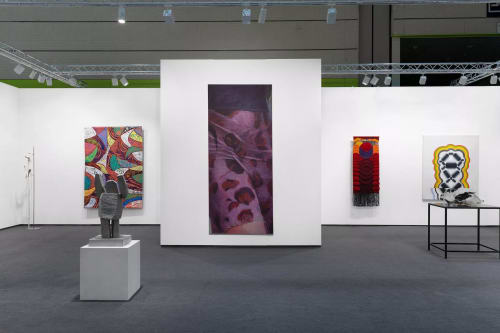Visitors to Seoul’s COEX center in Gangnam were blessed with pleasant weather yesterday for the VIP preview of Frieze Seoul. The fair, which returns for its third edition, features more than 110 galleries spanning 30 countries and is accompanied by the opening of the Korean International Art Fair (Kiaf), which also opened its concurrent VIP preview in the same location.
This year, Frieze Seoul is sprawling across the Korean capital. Frieze Film is taking place at Ewha Women’s University with evening outdoor screenings around its beautifully lit gardens and staircases. There is the newly added “unofficial” Euljiro Gallery Night celebrating nonprofit and independent spaces, followed by Samcheong, Hannam, and Cheongdam gallery nights throughout the week. Programming within the COEX has been bolstered too, with a new section for performance-based art, Frieze LIVE.
At the fair itself, the main section of galleries is supplemented with the return of Frieze Masters, showcasing the breadth of art history, and Focus Asia, highlighting Asia-based galleries established within the last 12 years.
As the doors to the COEX opened at 11 a.m. for the VIP preview, exhibitors in the first hour noticed the increase in curators and institutions at the fair perhaps due to the Gwangju and Busan Biennales elsewhere in the country, which are taking place southeast and west of Seoul. Curators from M+, New Museum, Detroit Art Institute, and Brisbane Museum of Art were among those spotted at the fair. “Busan and Gwangju seem to be a must for visitors this year,” noted MJ Khang of Kukje Gallery. Together with the maturation of art fairs in Seoul, the rising prominence of the two metropolitan cities is contributing to a widening and deepening of South Korea as an art nation.
The increase in institutional and curatorial visitors may also be attributed to the highly anticipated exhibitions of Korean artists in Europe and the U.S. in the months ahead. “There are years when there is only the market, but this year is when both the institutions and the market come together,” Danji Lee, director of Tina Kim Gallery, told Artsy. “Even though there are talks of a slowdown in the market that trouble the collectors, I’m feeling a vibrant energy and hearing that this is a great opportunity to get to know Korean artists.”
As the VIP day progressed, several reported sales began to trickle in, led by a $1.5 million Yoo Youngkuk painting from Seoul’s PKM Gallery. Other significant sales reported by galleries included a €1 million ($1.1 million) Georg Baselitz painting from Thaddaeus Ropac; a new painting by Avery Singer for $575,000 at Hauser & Wirth; a ₩736.73 million ($550,000) Robert Indiana sculpture at Pace Gallery; and a Jean-Michel Othoniel sculpture priced in the range of €93,000–€111,600 ($102,836–$123,403). Jessica Silverman’s solo booth of Istanbul-born artist Hayal Pozanti, who is presenting at the Gwangju Biennale’s American pavilion later this week, also sold out.
Check back on Monday for our round-up of reported sales from the fair. Here, we share the 10 best booths from Frieze Seoul 2024.
Booth B19
With works by Pacita Abad, Ghada Amer & Reza Farkhondeh, Wook-Kyung Cho, Ha Chong-Hyun, Gimhongsok, Suki Seokyeong Kang, Maia Ruth Lee, Mire Lee, Minouk Lim, Kang Seok Ho, Lee ShinJa, and Kim Tschang-Yeul
One of the first things visitors will notice walking into this year’s Frieze Seoul is the prominence of textile art. Conventionally pushed aside to the category of “craft” rather than fine art, it cannot be denied that the underestimation of textile art is directly linked to the underestimation of women artists.
Tina Kim Gallery’s presentation at Frieze Seoul 2024 is a celebration of this art and the artists. Works by Pacita Abad commemorate the artist’s recently concluded retrospective at MoMA PS1, while fiber artist Lee ShinJa’s first solo show will take place at the gallery’s New York space. Visitors can also get a sneak peek at the works of Mire Lee, in anticipation of the opening of her upcoming Tate Modern Turbine Hall commission.
Danji Lee, the director of the gallery, noticed this particular focus on Asian women artists of “unconventional” mediums is also being encouraged by major institutions in Seoul: “It’s not just us. There are many young artists showing at the National Modern Museum of Contemporary Art, Korea, and different generations of female sculptors at ARKO Art Center at the moment,” she said. “I want this to be known more.”
—Monica Jae Yeon Moon
